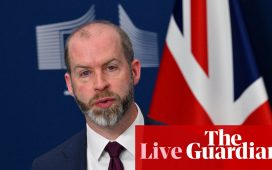Introduction: John Lewis Partnership narrows losses
Good morning, and welcome to our rolling coverage of business, the financial markets and the world economy.
The John Lewis Partnership has declared it is on track to deliver “significantly higher profit” this financial year, as it tries to put a troubled period behind it.
In its latest financial results, John Lewis has reported that its losses halved in the first half of its financial year.
The company, which owns Waitrose as well as the John Lewis department stores, has made a pre-tax loss of £30m in the six months to 27 July, down from £59m a year earlier.
Strip out ‘exceptional items’, such as the cost of strategic restructuring and redundancy programmes, and losses are down by 91% to just £5m.
Nish Kankiwala, CEO of the John Lewis Partnership, says the company has achieved a “marked improvement” compared with two years ago.
These results confirm that our transformation plan is working and we expect profits to grow significantly for the full year, a marked improvement from where we were two years ago.
We continue to invest heavily in quality, service and value, and customers are responding well – with more people shopping with us and customer satisfaction increasing. While we have much more to do, we’re well set up for a positive peak trading period and on target to significantly improve our performance for the full year.”
Looking across the company, Waitrose grew its sales by 5% in the first half of the year, but sales at its John Lewis department stores fell 3% – blamed on “a slower external environment for general merchandise”.
John Lewis returned to profit in the last financial year (to late January) after three years of losses.
Kankiwala says:
While we have much more to do, we’re well set up for a positive peak trading period and on target to significantly improve our performance for the full year.
The company is hoping that bringing back its “never knowingly undersold” price promise will help it win sales in the crucial Christmas period approaching soon…
The agenda
-
This morning: Chancellor Rachel Reeves to meet with UK bank bosses
-
9.30am BST: UK’s Office for Budget Responsibility to release its OBR Fiscal Risks and Sustainability Report
-
1.15pm BST: European Central Bank interest rate decision
-
1.30pm BST: US weekly jobless claims
-
1.45pm BST: European Central Bank press conference
Key events
Markets rally on interest rate cut hopes
European stock markets are rallying this morning, as traders anticipate an interest rate cut from the European Central Bank this afternoon.
Germany’s DAX index is up 1.1%, while France’s CAC 40 is 0.6% higher.
In London, the blue-chip FTSE 100 index hit a one-week high in early trading, and is currently up 71 points, or 0.9%, to 8265 points.
Analysts at RBC Capital Markets say it would be “a major surprise” if the ECB didn’t cut interest rates today by a quarter of one percent this afternoon.
They told clients:
The market is firmly priced for a 25bp rate cut at next week’, We and the analyst consensus are expecting a 25bp rate cut and most ECB speakers have already endorsed such a move.
IEA cuts 2024 oil demand growth forecast due to China slowdown
Slowing economic growth in China has prompted the International Energy Agency to cuts its forecast for oil demand this year.
The IEA has trimmed its 2024 oil demand growth forecast by 70,000 barrels per day (bpd), or about 7.2%, to 900,000 bpd.
That’s sharply lower than in 2023, when oil consumption rose by 2.1 million barrels per day.
In its latest monthly oil market report, just released, the IEA cites a slowdown in Chinese demand as the main driver of weaker global demand growth.
The report says:
The recent slowdown in China has seen its oil consumption declining y-o-y for a fourth consecutive month in July, by 280 kb/d.
The IEA now expects Chinese demand to grow by only 180,000 bpd in 2024 – citing a “broad-based economic slowdown” and an accelerating substitution away from oil in favour of alternative fuels.
Ryanair sees fares 5-10% lower for the rest of 2024
Budget airline passengers can look forward to lower fares this autumn.
Ryanair expects average fares to be 5% to 10% lower than last year for the remainder of this year, group chief executive Michael O’Leary told reporters before the Irish airline’s annual meeting on Thursday, Reuters reports.
Tonic maker Fevertree cuts revenue forecast due to wet weather
John Lewis isn’t the only company citing bad weather this morning.
Fever-Tree, the mixer maker, has reported that “poor weather in the second quarter across the UK and Europe” hit its revenues in the first half of this year.
Temperatures in June were dubbed “disappointing” by the Met Office, which will have deterred some drinkers from an outdoor G&T or ginger ale.
The company has now cut its sales forecast – it now expects revenue growth of about 4% to 5% this year, down from previous expectations of growth of about 10%.
Tim Warrillow, CEO of Fever-Tree, says the company has seen a much more positive trading performance in July and August, and are optimistic that growth will accelerate in the second half of 2024.
Warrillow says:
“The Fever-Tree brand performed well against a tough market backdrop. We continued to deliver double digit revenue growth in the US at constant currency, as well as a strong performance in our ROW region.
The first half performance in the UK and Europe was impacted by unseasonable weather at the start of summer alongside distributor order phasing in Europe, but we have seen a strong improvement in these regions as the summer belatedly arrived.
Shares in Fever-Tree have dropped almost 8% in early trading, to an eight-year low.
‘Unseasonal weather’ hits fashion sales at John Lewis
Sales of beauty products at John Lewis’s department stores rose in the last six months, today’s results show.
But fashion sales were hit by “unseasonal weather”, the company says, as well as the cost of living squeeze.
Other clothing retailers, such as Primark, have already reported that the wet and chilly summer hit sales.
Sales of homewear products were hit by lower demand for ‘big ticket’ items.
John Lewis adds that it “performed well in Technology”, particularly with sales of smart wearables and mobile phones.
Retail analyst Nick Bubb has dug into John Lewis’s results, and reports:
We are delighted that JLP has at last gone back to its previous policy of allocating central and property costs against the two Divisions, so that the operating profit splits are now much more realistic.
We are, however, very surprised that Waitrose was much less profitable than we thought on this basis last year and that John Lewis was therefore much more profitable than we’d thought: the adjusted operating margin at John Lewis of 1.7% last year (on ex-VAT sales) was actually higher than the 1.5% achieved by Waitrose (despite its H2 recovery.
John Lewis: Profits should be “significantly” over £42m this year
John Lewis points out that it has historically delivered the majority of its profits in the second half of the year.
The company says:
As a result, we are confident that full year pre-exceptional profits should be significantly above the £42m we reported in 2023/24.
The stronger second-half performance is thanks to the Christmas sales boom (memorably driven by Monty the Penguin a decade ago), and the new year sales.
Today’s John Lewis results are the final set before chair Sharon White hands over the reins to her successor, Jason Tarry, the former UK boss of Tesco.
On White’s watch, John Lewis has been investing in refurbishing its stores – it will soon complete this work at its sites at Oxford Street, High Wycombe and Cheadle; and nine Waitrose stores.
It is also opening of a new convenience store in Hampton Hill in London soon.
OpenAI’s valuation set to “hit $150bn” in new funding round
The value of artificial intelligence pioneer OpenAI appears to have almost doubled, according to reports, as the company seeks fresh resources in a new funding round.
Bloomberg reports that OpenAI – the organisation behind the ChatGPT chatbot and and the SearchGPT prototype – is in talks to raise $6.5bn from investors at a valuation of $150bn (£115bn).
The new valuation is significantly higher than the $86bn valuation achieved in a tender offer earlier this year, confirming OpenAI as one of the most valuable startups in the world.
It’s the latest sign that OpenAI has put last year’s boardroom disruption, which saw CEO Sam Altman fired and then rehired a few days later, behind it.
The increased valuation has been achieved despite concerns that the artificial intelligence bubble may have burst – given recent declines in tech share prices.
Introduction: John Lewis Partnership narrows losses
Good morning, and welcome to our rolling coverage of business, the financial markets and the world economy.
The John Lewis Partnership has declared it is on track to deliver “significantly higher profit” this financial year, as it tries to put a troubled period behind it.
In its latest financial results, John Lewis has reported that its losses halved in the first half of its financial year.
The company, which owns Waitrose as well as the John Lewis department stores, has made a pre-tax loss of £30m in the six months to 27 July, down from £59m a year earlier.
Strip out ‘exceptional items’, such as the cost of strategic restructuring and redundancy programmes, and losses are down by 91% to just £5m.
Nish Kankiwala, CEO of the John Lewis Partnership, says the company has achieved a “marked improvement” compared with two years ago.
These results confirm that our transformation plan is working and we expect profits to grow significantly for the full year, a marked improvement from where we were two years ago.
We continue to invest heavily in quality, service and value, and customers are responding well – with more people shopping with us and customer satisfaction increasing. While we have much more to do, we’re well set up for a positive peak trading period and on target to significantly improve our performance for the full year.”
Looking across the company, Waitrose grew its sales by 5% in the first half of the year, but sales at its John Lewis department stores fell 3% – blamed on “a slower external environment for general merchandise”.
John Lewis returned to profit in the last financial year (to late January) after three years of losses.
Kankiwala says:
While we have much more to do, we’re well set up for a positive peak trading period and on target to significantly improve our performance for the full year.
The company is hoping that bringing back its “never knowingly undersold” price promise will help it win sales in the crucial Christmas period approaching soon…
The agenda
-
This morning: Chancellor Rachel Reeves to meet with UK bank bosses
-
9.30am BST: UK’s Office for Budget Responsibility to release its OBR Fiscal Risks and Sustainability Report
-
1.15pm BST: European Central Bank interest rate decision
-
1.30pm BST: US weekly jobless claims
-
1.45pm BST: European Central Bank press conference








